Svenska Marinen: The Scandinavian heavyweight
 Circa 60 vessels in 1914-18, from Coast Defence ships to torpedo boats and submarines
Circa 60 vessels in 1914-18, from Coast Defence ships to torpedo boats and submarines
After the end of the union between the Norwegian and Swedish crowns, desired by Bernadotte in 1814 and completed smoothly in 1905, Sweden was left alone to control the passage of Kattegat and Skaggerak to the North Sea and de facto possessed the major part of the Baltic, the other being under Russian control, the old antagonist.
Sweden was twice as lucky as its Scandinavian neighbors to have significant industrial resources and a very sea-friendly population with a history comparable to that of the Royal Navy. The parliament approved the construction of coastal battleships of a tonnage and firepower that eclipsed all those produced so far. Already considered the most powerful fleet of all Scandinavian countries, the Svenska Marinen was not far behind traditional European heavyweights like Holland and Spain.
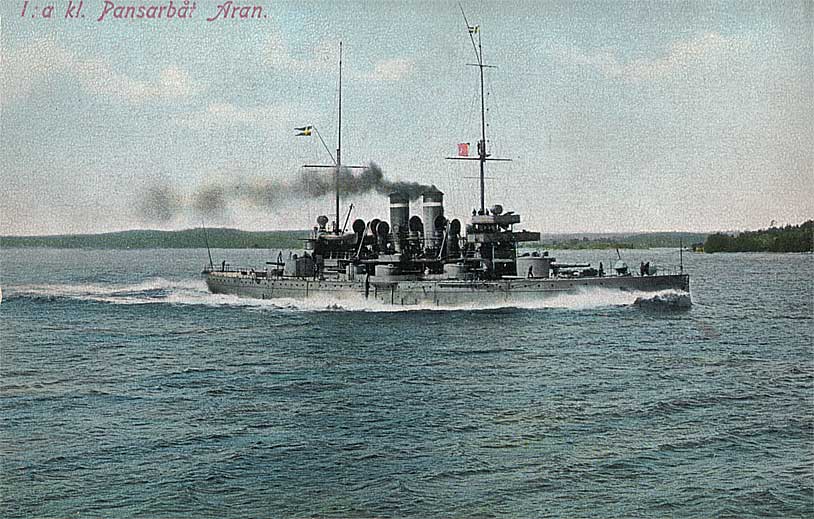
Coastal Battleship HMS Aran
The edge in submarines
One of the originality of the fleet was to have been a pioneer in submersibles, especially with the Nordenfelt class, produced by Bolinders Mekanika Verkstad and Nordenfelt, Karlsvik in Stockholm. Nordenfelt was also a major weapons manufacturer and its quick-firing naval guns were known in any Navy of the time.
In 1885 these submersibles made a great impression after an international presentation and were sold to England, Greece, Turkey, and Russia. They preceded for more than 10 years the first submarines made by Laubeuf and Holland. This tradition continued afterward, and by 1914 Sweden introduced a powerful submersible force.
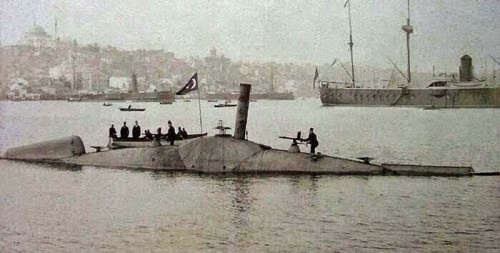
Nordenfelt type submarine in Turkish service
Infrastructure
Swedish naval bases were at Karlskrona, the main one, fortified at Vauban, possessing 6 large dry docks and a base for submersibles, Stockholm, forts, coastal batteries, 3 dry docks, and base torpedo boats, and Gothenburg. Two other bases were located at Farösund in Gotland and Hemsö in the Gulf of Bothnia. The navy, commanded by an admiral, was divided between the coastal defense and the fleet, divided into squadrons. The coastal defense was not limited to forts but included many well-protected batteries in granite bunkers, rail batteries, but also minelayers.
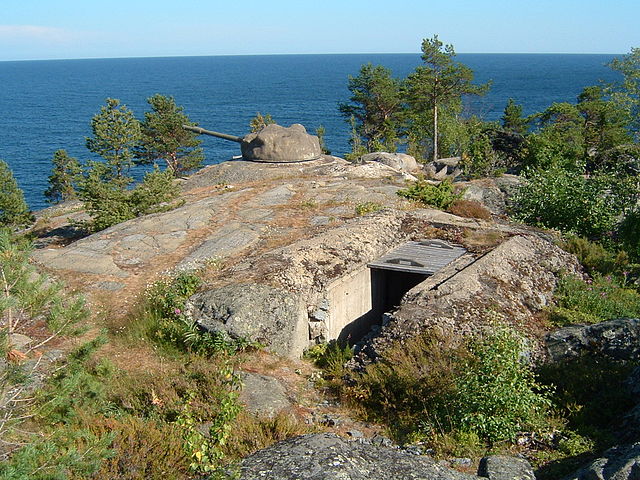
Hemsö fortress, strategically located in the Ångerman River outlet (built 1860s)
Overall strenght in 1914
Even for the Hochseeflotte, an invasion of Sweden (never a strategic goal for Germany) would not have been a cakewalk. These were the forces deployed by this country in 1914:
12 Coastal Battleships: 4 class Aran (1901), Oscar II (1905), Dristigethen (1900), 3 class Oden (1896), 3 class Svea (1886). 3 in construction class Sverige.
10 coastal Monitors: 3 Ericsson class (1865), 2 Skjöld class (1871), 5 Berserk class (1873).
7 Cruisers: Fylgia (1905), 5 torpedo-cruisers class Ornen (1896), Clas Fleming (1912).
8 Destroyers: 2 class Hugin (1910), 3 class Ragnar (1908), Wale (1907), Magne (1905), Fashion (1904), 2 other under construction.
49 Torpedo Boats:
-First class: 17 Plejad class (1905), 12 Komet class (1896), 2 Gondul class (1894), 3 Munin class (1886), Hugin (1884).
-Second class: 4 class No. 79, 2 class Agne, 2 class Bygve, 2 class Narf, Galdr, Blixt, Blink.
8 Submersible: Hajen (1904), Hvalen (1909), 3 class Undertvattensbaten No. 2 (1909), 2 in completion class Svärdfisken (1914), Delfinen (1914).
9 Miscellaneous: 2 Blenda class gunboats (1874), 5 Urd class (1877), Edda (1885), Angkanpramen minesweeper No. 9 (1912).
Tonnage 1914:
Coastal Battleships 12 – Monitors 10 – Cruisers 7 – Destroyers 8 – Torpedo Boats 49 – Submersible 8 – Miscellaneous 9
Articles Done and Upcoming
- HSwMS Äran class coastal batteships (1901)
- HSwMS Clas Fleming (1912)
- HSwMS Dristigheten (1900)
- HSwMS Oscar II (1906)
- Oden class coast defence ships (1897)
- Svea class coast defence ships (1886)
- Sverige class (1915)
J. Ericsson class monitors (1865)
Gerda class monitors (1871)
Berserk class monitors (1873)
Armoured Cruiser HMS Fylgia (1905)
Minelaying Cruiser Clas Fleming class (1912)
Swedish Torpedo cruisers
Swedish destroyers
Swedish Torpedo Boats
Swedish gunboats
Swedish submarines
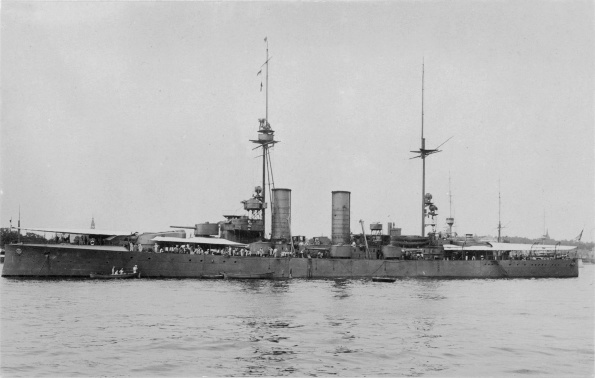
HMS Swerige, ww1-built coastal battleship.
The Swedish Navy during the First World War:
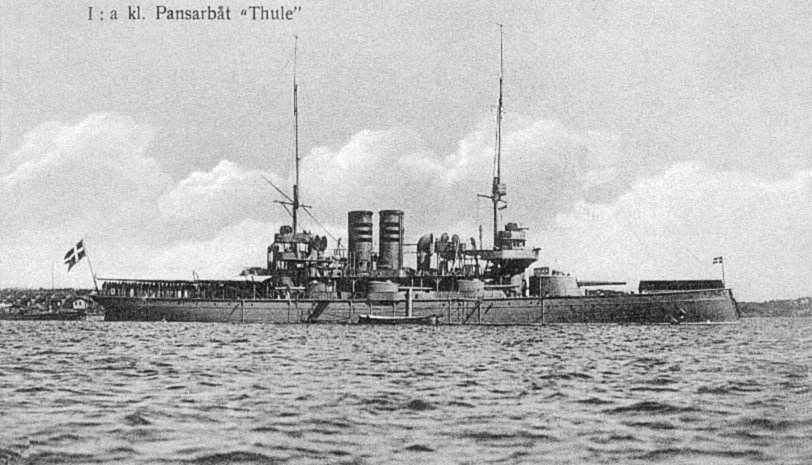
Coastal Battleship HMS Thule
During the July 1914 crisis, King Gustaf and Knut Wallenberg (Swedish foreign minister), gave strict assurances to the Central Powers that an alliance with Russia was excluded in all cases. Sweden issued an official declaration of neutrality at the start of the conflict but with a reserve to take action later. In Germany, the general tone of this total rejection of Russia make the general staff think that if pushed too far, Sweden would choose Central powers side;
Wallenberg, fearful that the Kaiser would send an ultimatum to force Sweden to take side, reassured Franz von Reichenau that this neutrality would be “benevolent” to Germany. In addition, negotiations took place with the other Scandinavian powers (to avoid for example a sympathetic Norway to the British cause to take a side), compounded in a common official declaration of neutrality by the kings of Denmark, Norway, and Sweden in December 1914.
The next year, however, Germany tried hard to draw Sweden in their new dreamed scheme of “Mitteleuropa”, starting by Zimmermann making offers for a “Nordic block” dominated by Sweden, and later concessions including the Åland Islands in return for a joint attack on St.Petersburg, other zones of influence and the promise of a neutral Finland.
The government never flinch despite favorable views by King Gustav, but the Germans gained a secret concession out of these repeated efforts: They were granted the right to communicate with their embassies via Stockholm, through the Swedish network as their communications were censored and intercepted by the British. However in late 1915 one such German telegrams were intercepted by the British, noticing that certain Argentine ships be “sunk without trace”, and this caused a scandal.
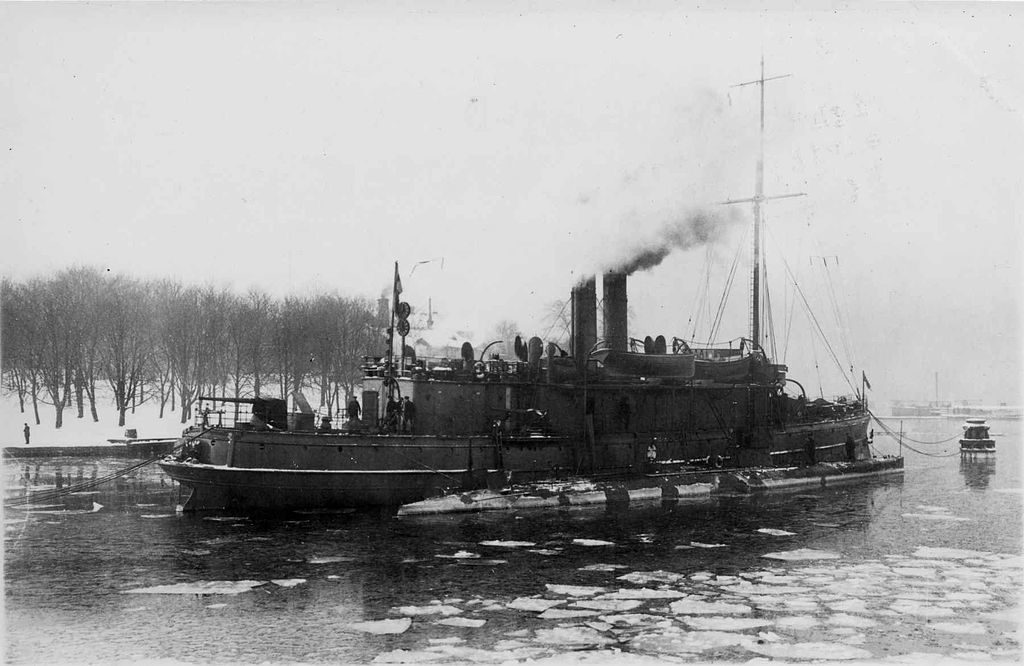
HSwMS Hvalen and Skäggald depot ship, supplying the submarine in 1915. Notice either snow of winter paint on the submarine’s hull. HSwMS Hvalen was later mistaken for a British submarine and hit by a German vessel.
By pressure, Germany obtained the closure and mining of the strait approach by Denmark and Norway, but Sweden resisted demands that its side of the Øresund should be mined.
Eventually, Germany renounced but asked, and obtained the promise that Sweden’s lighthouses in the Øresund would be switched off and markers removed in case of an incursion of the Royal Navy. The case applied in October 1915, when British submarines made an incursion through the sound, sinking several german freighters and the armored cruiser SMS Prinz Adalbert..
A Swedish submarine, HSwMS Hvalen, certainly mistaken for a British one, was hit by accident by a German ship and this incident triggered official apologies and a compensation. After the summer of 1916, Sweden eventually complied to German pressure and mined the Kogrundsrännan channel (Oresund straits), drawing allied criticism about the move.
Another interesting aspect of the time was the move of respective iron-ore trade routes: Through government pressure, which was a member of the board of iron-ore production association, export was fixed at 22,500,000 tons maximum. But during wartime, all the production of the iron ore fields of Gällivare in the Baltic were re-routed from the allies to Germany, while at the contrary, the iron-ore fields of Kiruna exported via Narvik, went to the allies.
A small percentage was still delivered to Germany, by sticking to the Norwegian coast or Norwegian waters. An allied demand after the entry of the USA into the war was to reduce these exports to Germany in exchange for food deliveries to Sweden, that was also hit by the blockade. This question divided the parliament and provoked the fall of Sweden’s PM Hjalmar Hammarskjöld.
By the end of 1917, the German Army was about to seize St Petersburg and the German Secretary of State for Foreign Affairs renewed his demands to the Swedes to supply the Germans, in exchange to the Åland Islands that would be occupied by the Germans and then transferred to Swedish sovereignty.
After the Finnish independence was acted and recognized by Sweden on 4 January 1918, but there were still reservations about the islands until rumors of Russian atrocities created a stir in Sweden and a reaction on 13 February 1918.
An expeditionary force was sent to occupy the Islands. Meanwhile, the Finns also revendicated the islands, which led to a joint German-Swedish occupation until 25 April 1918, after which the Swedes retired and the Island was ceded to the Finns.
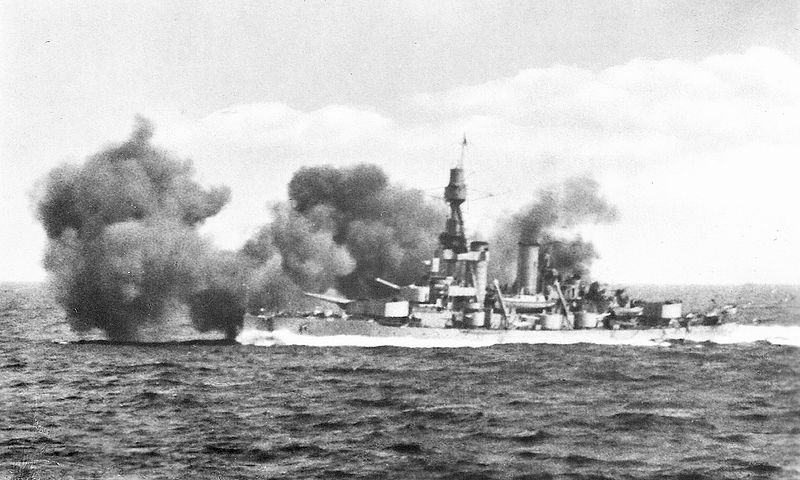
Swerige in firing exercises.
Sweden did not have a hard time keeping neutrality in the light of its naval arguments, so much so that after the virtual destruction of the Russian fleet during the Baltic civil war and the internment and later scuttling of the Hochseeflotte it remained the strongest naval force of the Baltic.
Sweden’s actions were limited to ensuring that costs were not violated by one or the other belligerent and to maintain the good progress of its trade efficiency, seriously reduced though, by the British blockade. From 1917, Swedish merchant ships were targeted by U-Bootes as well as others, and neutrality policy often flouted.
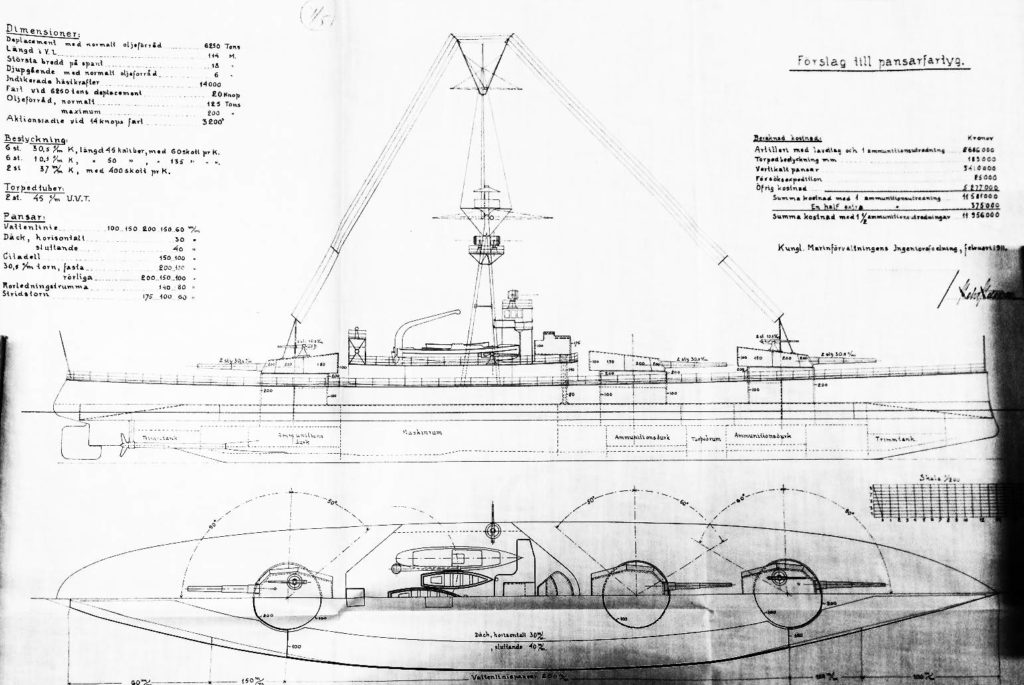
Enchanced swerige-class coastal battleship project, before the post-war ban of new constructions: It would have been armed with 6x 305 mm and 6x 105 mm guns.
In addition, since Sweden’s workforce was free from any engagement, naval yards could work at full pace, and three Sverige-class coastal battleships, three Wrangel class destroyers and seven submersible of Laxen, Abboren and Hajen classes, three minesweepers were however built. In 1919, Sweden emerged from the conflict relatively shaken but still confident in the future.
However, an unprecedented pacifist movement took over the country, which set aside all shipbuilding programs for years. Until 1939, numerous withdrawals of obsolescent units reduced the overall tonnage considerably. It was not until 1936 that Sweden’s confidence in the League of Nations began to decline and plan for rearmament was drawn up.
Svenska Marinen in detail
Coastal battleships
Sverige class (1916)
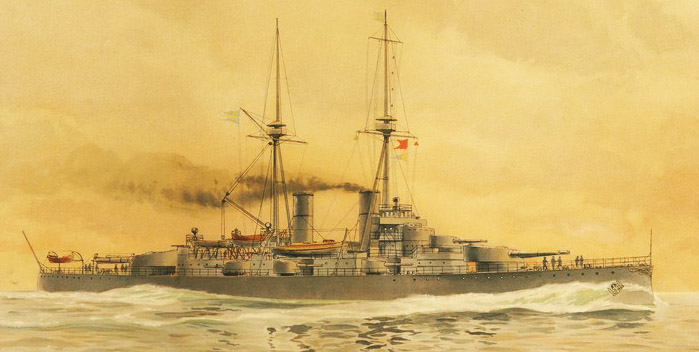
Rendition of the future Sverige in 1912 during the fundraising campaign, now at the Sjöhistoriska museet
The Sverige-class coastal battleships were the largest ships ever to serve in the Swedish Navy at that point. Their design was totally new and inspired by other nations’ own dreadnought designs. Their armament was head and shoulders above the previous Oscar II (see below) with four 283 mm (11 in)/45 cal.
Bofors guns in twin turrets (rather than two 210 mm in single turrets) and eight 152 mm (6 in) Bofors guns a single superfiring twin turret and six single broadside. Just one on three was ready on time to serve at the end of WW1 but all three formed the backbone of the Swedish Navy during WW2, next interwar constructions revolving around cruisers, destroyers, and submersibles.
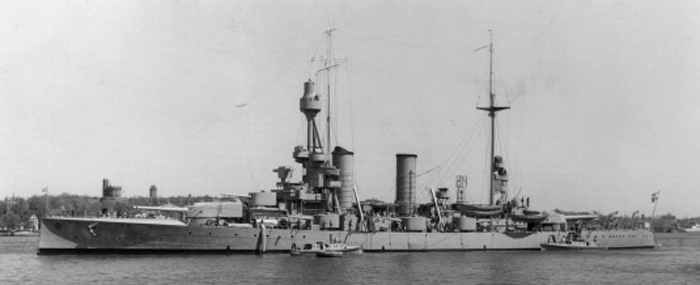
Sverige in 1929, before modernisation
“Sverige” (“Sweden”) had a special fate. She was initially decided in 1911 to start the type F submitted by the Admiralty and chosen by the parliament. It was funded and voted. However there was a change of government the next year and the new liberal majority prime minister Karl Staaff decided against the ship, postponing it until an exhaustive analysis takes place to motivate any further decisions.
However soon a national move helped a campaign quickly to raise more money (over 15 million crowns) that was voted in 1911 (12 million), called the “Pansarbåtinsamlingen”. Therefore the government was cornered to authorize the construction of the first ship, which was called “the people’s gift to the country”.
The two next ships were voted in 1914 by the same government, now with a war on hands, called Drottning Victoria and Gustav V. Both were laid down however in 1915 due to material shortages and launched in September 1917 and January 1918 respectively. Meaning none was ready when the war ended, as both were completed in 1921 and 1922. They were modified with the experience of the Sverige and also modified in the interwar. Both would be studied more in detail in the Swedish Navy WW2 page.
Design
The Sverige-class was a new take on the coastal Defence ship, with an heavier armament, better speed, and armor. But still, the hull was tailored not for high seas but for local archipelagos and shallow waters.
Their tactical doctrine and operations were also new. Indeed they formed the core of an open-sea battle group (which should have originally comprised four and not three ships), and were meant to operate with cruisers, destroyers, torpedo boats, but also air reconnaissance. This small battle group was to operate as a defensive force only.
During WW2 this doctrine was still active and indeed they offered a smaller target to submarines, torpedo crafts or dive-bombers and minefields, some authors suggested they were taken in consideration in the decision by the Germans high command in WW2 not to invade Sweden in 1940. In fact, Jane’s 1938 edition classed these ships as battleships due to their use in a coherent battle group.
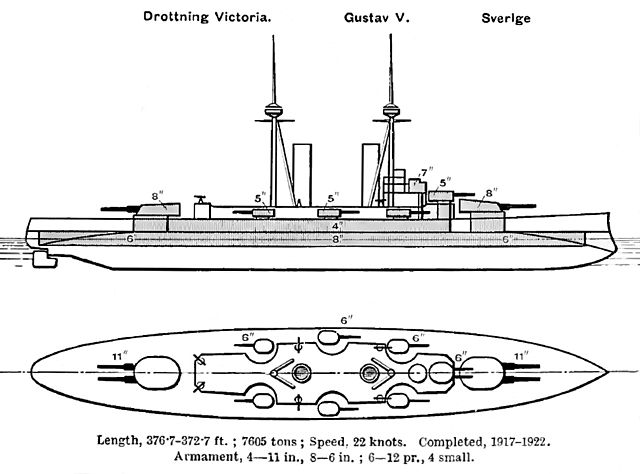
Brassey’s Naval annual armour scheme of the class, 1923
At 12 meters long and 6,852 tons standard, up to 7,516 tons fully loaded for the HSwMS Sverige, they were of another level also compared to Oscar II. Probably in 1914 they were the meanest coastal ship in any navy of the time, worthy of a “pocket dreadnought”.
The armament comprised four 283 mm (11 in) 45 cal. Bofors that were equivalent to the German main battleship caliber of the time. However, the rate of fire was about 17 seconds and the turrets were rather cramped because of the partition between guns inside both turrets. The eight 6 in/50 caliber QF guns in twin and single turrets were rather a modern arrangement, more than usual broadside barbettes.
In addition, four 75 mm (3 in) Bofors AA cannons were mounted forward of the rear turret already. There were also two anti-ship QF 57 mm (2.2 in) short-barreled Bofors and nine 6.5 mm (0.26 in) Machine-Guns, plus two 457 mm (18.0 in) torpedo tubes.
Armor scheme included a 200 mm (7.9 in) thick belt in the central section down to 100 mm (3.9 in), to 60 mm (2.4 in) ends, the upper section was 100 mm (3.9 in) behind fore barbette and aft barbettes. The twin main turret was 200 mm (7.9 in) on the front, and down to 100 mm (3.9 in) on the sides and a 50 mm (2.0 in) roof.
The Barbettes were 150 mm (5.9 in) above the ammo wells, and the secondary turrets 125 mm (4.9 in) thick with 100 mm (3.9 in) barbettes. The forward conning Tower was 175 mm (6.9 in) in thickness and the decks ranged from 45 to 30 mm (1.8 to 1.2 in). All in all it 50 mm more compared to Oscar II, sufficient to deal against Armoured cruisers of the time, but a bit light to face contemporary battleships.
To propel these 7000 tons monsters, the machinery comprised four shafts coupled to Curtis turbines rated for 20,000 SHP total and 12 Yarrow-type coal-fired boilers. This figure was for the Sverige only.
See the WW2 section for the two others (one had Westinghouse geared turbines rated for 22,000 SHP) and were upgraded in the interwar to oil-fired models.
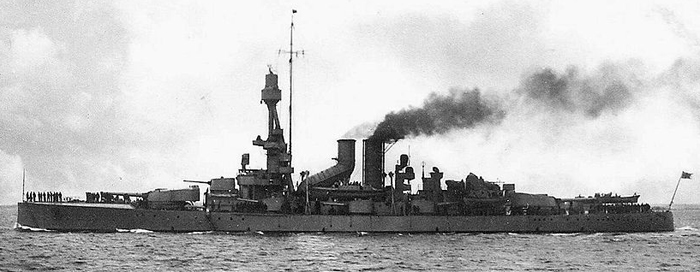
Sverige in 1931
Operational service
As said above, only HSwMS Sverige was ready to take part in WW1, being ordered in 1912, laid down in December 1912, launched in 3.5.1915, and completed in 10.5.1917 by Götaverken Gothenborg.
All three ships looked similar until reconstruction during the interwar and further wartime additions, but this is for the WW2 Swedish navy chapter. it’s hard to point out a pracise career of the Sverige as that point, since she only served actively in 1918, and her only sortie was to take the Aaland islands from the Russians in 1918 (see above).
Sverige 1917 |
|
| Dimensions | Length 120 x 18.6 x 6.25 m |
| Displacement | 6850 tonnes, 7700 tonnes FL |
| Crew | 427 |
| Propulsion | 4 shafts, Kockums-Curtis Turbines, 12 Yarrow boilers, 20,000 shp |
| Speed | 22.5 knots as designed |
| Range | 2720 nm at 14 knots |
| Armament | 4 x283, 8 (1×2, 6×1)x 152, 2x 75, 2x 57, 2x 6.5mm MG, 2x 450mm TTs |
| Armor (max) | Belt 200, Barbettes 150, turrets 200, sec turrets 125, decks 45-30 mm, CT 175mm |
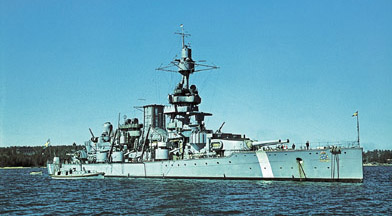
HSwMS Oscar II (1905)
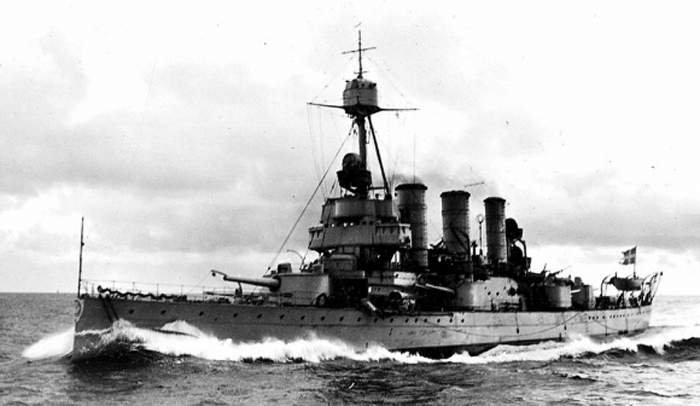
Oscar II was one of the longest-living, active ship in the western hemisphere. This Pansarskepp, a development of the Äran class, was intended to carry a more powerful armament in order to outclass any enemy armored cruiser, by also speed and protection (which was as good as any battleship).
She was also the last coastal battleship in existence when she was broken up in 1974. This was the most modern vessel in the Swedish inventory when the war broke out in 1914.
She was a modernized and larger Äran class, displacing 4,273 and up to 4,584 long tons at full load. 95.6 m (313.6 ft) long, 15.4 m (50 ft 6 in) wide, with a 5.49 m (18 ft 0 in) draft, she carried nine officers for HQ purposes plus a normal crew of 342. Built at Lindholmens, Gothenburg for a cost of 3,390,000 crowns, she was launched on 10 June 1905 and completed, commissioned on 3 April 1907.
She was modernized four-time First, in 1910 when receiving a tripod mast to mount a better rangefinder, gradual upgrades and in 1916 she received new high angle AA mounts for two 57 mm (2.2 in) guns. During the war, she served as flagship, between firing and damage control exercises. She saw action during the invasion of Åland in 1918, 19 February, along with HMS Sverige to land and cover operations of a Marine contingent from the Vaxholm Coastal Artillery Regiment.
On 5 March she saw the German battleships Rheinland and Westfalen but stayed there as a Swedish display of force, the last ship to leave the islands on 23 April. She was also decommissioned in September 1918 for a complete overhaul. Other modernizations intervened during the interwar and WW2, but’s for the Swedish WW2 navy section. She remained in service until February 1950 and afterward the hulk, disarmed, still served for training until the mid-1970s.
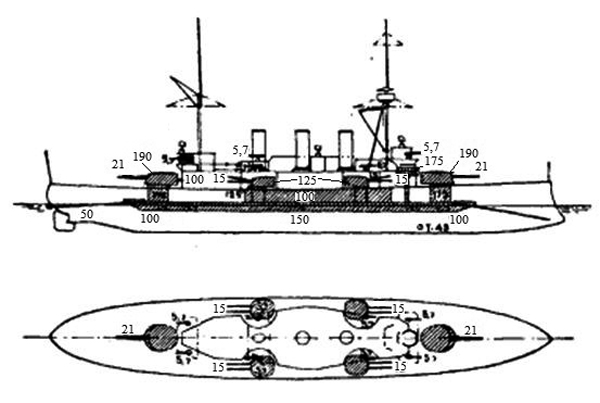
Armament
HMS Oscar II was armed by two 210 mm (8.3 in) Bofors M/98 guns (like those of Aran) (which was less than the twin pairs of 254 mm of contemporary armored cruisers, eight 152 mm (6 in) Bofors M/03 guns in twin turrets, ten 57 mm (2.2 in) Finspång M/89B guns, three 37 mm (1.5 in) Bofors M/98B guns and two 450 mm (18 in) torpedo tubes.
Protection
It was a clear improvement over the Aran, with especially it the lower decks. The belt was 67 m (219 ft 10 in) long (Schneider-Creusot) and 150 mm (5.9 in) midships with 125 mm (4.9 in) to 100 mm ends. The turrets were plated by 60 and 125 mm (2.4 and 4.9 in) thick Krupp armor.
The citadel was 23 m (75 ft 6 in) long between the turrets, 100 mm (3.9 in) thick. Barbettes were 175 mm (6.9 in) thick. The main deck was 60 and 22 mm (2.4 and 0.9 in) thick. Conning towers were 157 mm (6.2 in) forward and 100 mm (3.9 in) aft. The bridge, upper decks were 10 and 57 mm (0.4 and 2.2 in) thick respectively. All in all, this was better than many armored cruisers, which compensated for the firepower.
Propulsion
The beating heart of Oscar II was a group of two Motala Verkstad four-cylinder, triple expansion engines. They drove two shafts, with a three-bladed propeller. Rated at 9,400 shp (7,000 kW) they were fed by ten 16.5 kg/m2 (3.4 lb/sq ft) water tube marine Yarrow boilers and separated in three watertight compartments.
For this arrangement, the Oscar II ended as the only three-funneled coastal defense ship at the time. For range, she also carried 500 long tons (510 t) coal for about 3,550 nm (6,570 km) at a cruise speed of 11 knots (20 km/h) reduced to 1,100 nm when speeding up to 17.8 knots, which was about 33.0 km/h). On trials, she reached 18.14 knots (33.60 km/h).
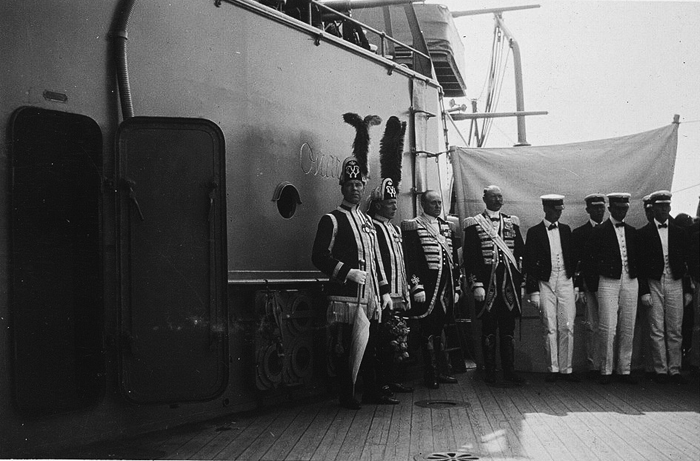
Officers on deck while visiting the Tsar of Russia in 1912
Oscar II 1914 |
|
| Dimensions | Length 95.6 x 15.4 x 5.49 m |
| Displacement | 4273 tonnes, 4584 tonnes FL |
| Crew | 335 |
| Propulsion | 2 shafts, Motala VTE engines, 10 Yarrow boilers, 9500 shp |
| Speed | 18 knots as designed |
| Range | 3550 nm at 10 knots |
| Armament | 2 x210, 8 (4×2)x 152, 10x 57, 3x 37mm, 2x 450mm TTs |
| Armor (max) | Belt 150, Barbettes 175, turrets 190, sec turrets 125, decks 22, Fw CT 157mm |
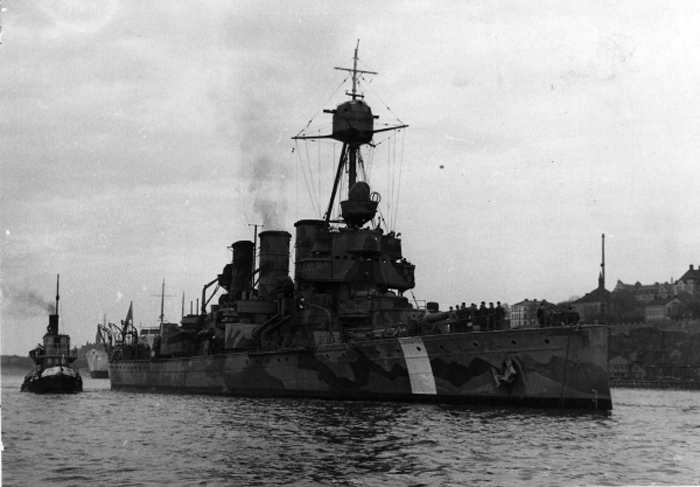
Oscar II during WW2.
Äran class coastal battleships (1901)
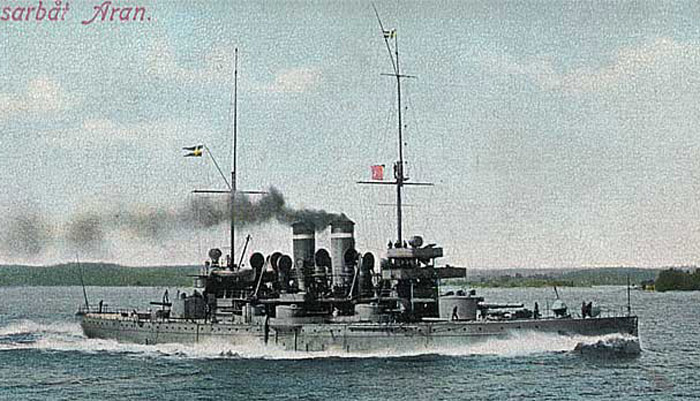
This class comprised the HSwMS Äran, Wasa, Tapperheten and Manligheten, which made the bulk of swedish coastal defensive screen in 1914. The second (HSwMS Vasa) was a famous name, dear to the hart of any Swede when thinking of the Navy. This was the largest warship in its time, back in the 1600s when the Swedish Navy was reaching its peak of power and Sweden was a major actor in European affairs.
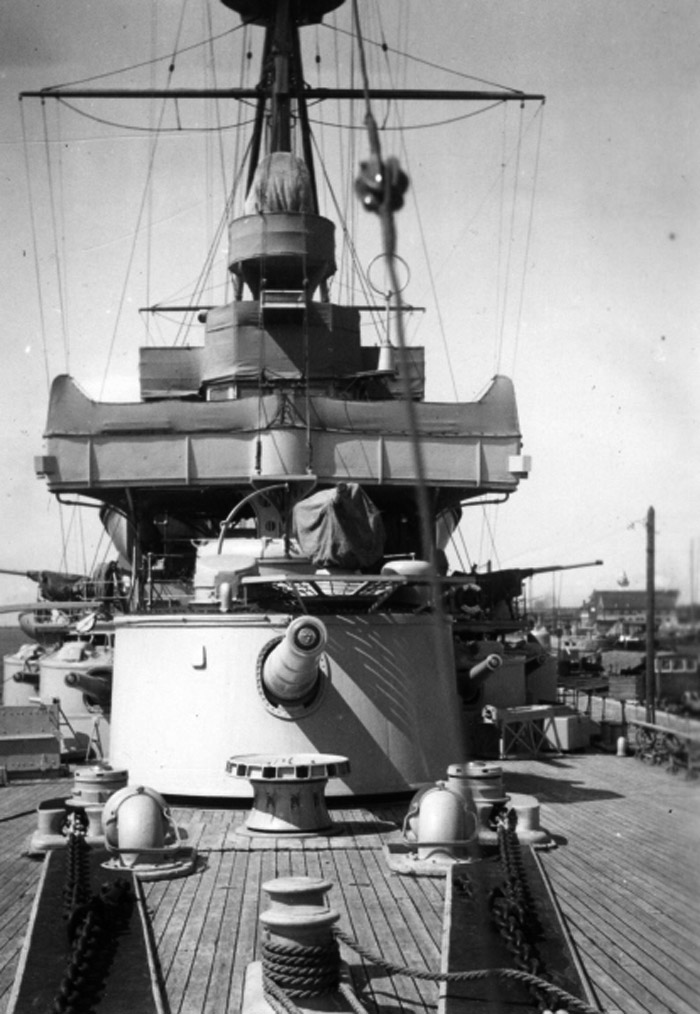
Manligethen forecastle
This class of Pansarskepp was 87.48 m (287 ft 0 in) in length for 15 meters (49 ft 3 in) in the beam, and 5 meters (16 ft 5 in) draught, better suited to shallow waters of this rea. This came with a displacement of 3,592 tons. All four ships were propelled by two shafts connected to reciprocating VTE engines rated at 6,500 indicated horsepower (4,800 kW). Tapperheten produced 550 hp, for 16.5 knots.
Their Krupp cemented and KNC armor comprised a 7 in (18 cm) belt and 7.5 in (19 cm) thick armor plates on the turret. The main armament consisted in two 210/44 mm (8.2 in) bofors single turret guns and six single 150/44 mm bofors guns (6 in) plus ten 5.7 cm (2.2 in) Bofors QF guns, and the usual two submerged 457 mm (18 in) torpedo tubes. They differed from the previous Dristigethen (1900) in having the 6 in guns in turrets amidship and not in barbettes.
Their active life was spent in exercises, without notable fact to be reported here. Built at Bergsund, Finnboda, Kockums, Malmö (2 ships) and Lindholmens, Gothenborg, launched in 1902 to 1904, they served through WW1 and the interwar, and were still active in WW2 after a thorough modernization. To see these records, see the WW2 Swedish Navy section.
Äran class 1914 |
|
| Dimensions | Length 87.5 x 15 x 5 m |
| Displacement | 3592 tonnes, 3900? tonnes FL |
| Crew | 285 |
| Propulsion | 2 shafts, Motala? VTE engines, 8? boilers, 6500 shp |
| Speed | 18 knots as designed |
| Range | 3550 nm at 10 knots |
| Armament | 2 x210/44, 6x 152/44, 10x 57, 10x 57mm QF (6 pdr), 2x 450mm TTs |
| Armor (max) | Belt 7 in, turrets 7-1/2 in Krupp cemented and KNC armor |
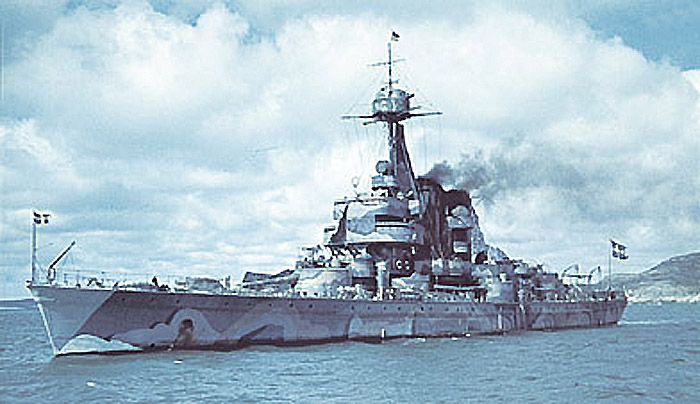
Manligethen in WW2
HSwMS Dristigethen coastal battleship (1900)
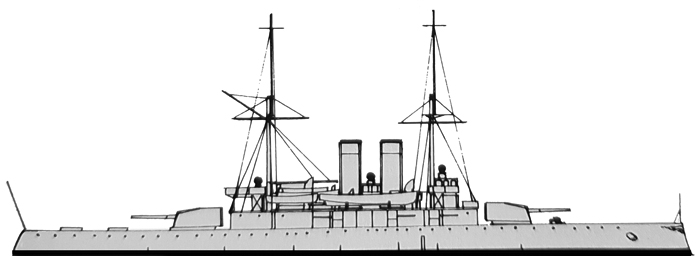
Conway’s profile of the HSwMS Dristigethen
This single coastal battleship preceded the Äran class and was a prototype in some way since the five ships shared a lot in common. HSwMS Dristigethen was launched at Lindholmen in 1900. She was slightly smaller than the Äran at 3445 tons standard with a slightly reduced machine power rated for 5400 hp, resulting in a 15.5 knots top speed. She could carry 5000 tons of coal.
HSwMS Dristigethen was armed with about the same way the following Äran, two 210 mm Bofors naval guns in single turrets fore and aft, six Bofors 150mm, ten 6-pdr and two TTs, but the secondary 6-in guns were arranged in barbettes along the central battery and citadel.
Protection-wise, they received Harvey steel, with a 8 in strong belt (200 mm) and 6 to 8 in turrets (sides and front) or 150 to 200 mm.
HSwMS Dristigethen served during WW1, enforcing swedish Neutrality, and in 1924 she was rebuilt at an aircraft and repair depot ship anchored at Bergsund, Stockholm. Tonnage was reduced to 2218 tons standard (270 FL) after the removal of armour and main armament. She was rearmed during WW2 with four 75 mm AA, 2x 40 mm AA and four machine guns. See also the WW2 section.
Oden class coast defence ships (1897)
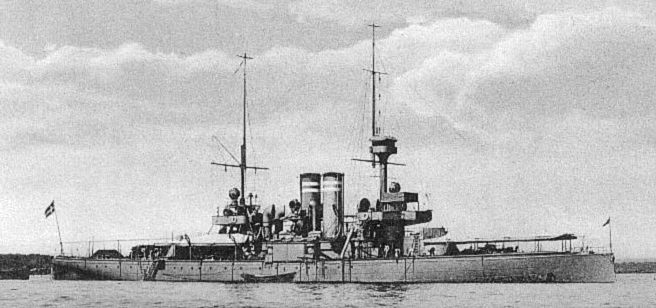
The first of these three ships was HSwMS Oden (launched at Bergsund in 1897), followed by HSwMS Thor (same yard, 1899) and HSwMS Niord at Lindholmen also in 1899.
Armament-wide their main artillery was impressive, with two single 1 in/42 caliber guns (254 mm) and six 4.7 in (120 mm) secondary guns in barbettes, plus ten QF 6-pdr Bofors (47 mm) in single mounts to fight TBs and a single 450 mm (8 in) torpedo tube.
They displaced 3445 tons standard, and were propelled by two 2 shaft reciprocating engines, VTE engines rated for 5350 ihp, giving them a top speed of 16.5 knots. The also carried 300 tons of coal.
Oden was originally armed with four 6-pdr and eight 3-pdr (47 and 37 mm). For protection, they all received a 9-1/2 in (240 mm) armored belt, and 8-in plating (203 mm) on their turrets. Oden had 10-in plating front of the turrets and Creusot rather than harvey steel like Thor and Niord. All three were active in WW1 without notable incident to be reported.
Oden class 1914 |
|
| Dimensions | Length 84.8 x 14.8 x 5.3 m |
| Displacement | 3445 tonnes standard |
| Crew | 254 |
| Propulsion | 2 shafts, VTE engines, 8? boilers, 5350 ihp |
| Speed | 16.5 knots as designed |
| Armament | 2 x254/42, 6x 120/45, 10x 57, 10x 57mm QF (6 pdr), 1x 450mm TT |
| Armor (max) | Belt 9-1/2 in, turrets 10-8 in Harvey/Creusot armor |
Svea class coast defence ships (1886)
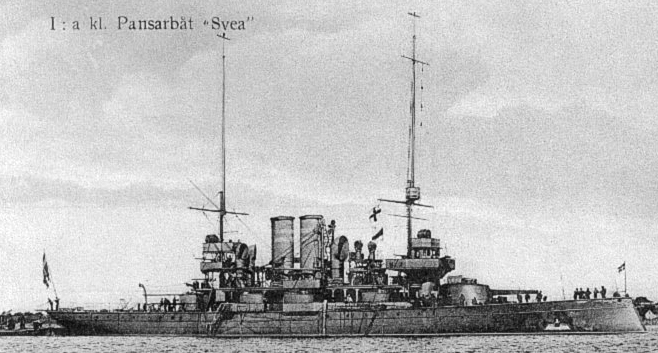
The Svea class of three ships were the most modern in the Swedish arsenal since 1871, which date saw the launch of a sea-going monitor, HMS Loke, close to the previous 1860s John Ericsson class. HMS Svea was launched at Lindhoklmen in 1886, followed by Göta same yard, 1891 and Thule in 1892.
They were true sea-going coast defence ships with an admiship belt and two 10 in guns in a single turret. However in 1901-1904 they were completely rebuilt. Their new armament comprised a single 8.3 in /44 gun in a single 7-1/2 in thick KNC steel turret and seven 6-in guns in single turrets each side, plus 11 6-pdr light QF guns for TB warfare whereas the three original 380 mm TTs were deposed. All three had a stern projeted forward, but only Thule had an actual ram.
They displaced 3200 tons, for 75.7 metres (248 ft 4 in) in lenght, a draught of 5.18 metres (17 ft 0 in) and reciprocating engines rated for 4,700 ihp (3,500 kW) giving them 16 knots (30 km/h) top speed. Svea’s machinery actually was rated for 3640 ihp, giving 14.7 knots.
They were protected by a belt ranging from 11-1/2 in in the central section, down to 8in at the ends. Their main initial turret was protected by 11-1/2 in thick Creusot steel (Svea had compound steel) on the front, and 9-1/2 in on the sides.
All three were active during WW1, without notable issue. The new turrets has been forged and placed at Ellenabbsfortet (Aspö, a small island near Karlskrona) and the guns were removed in 1936 while the turrets were deposed and scrapped.
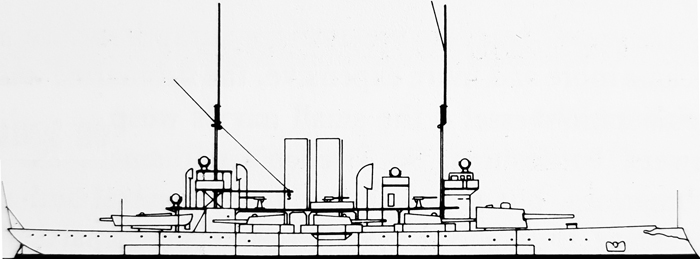
Profile of the Svea (Conways) after reconstruction, as of 1914.
Svea class 1914 |
|
| Dimensions | Length 75.7 x 14? x 5.18 m |
| Displacement | 3200 tonnes standard |
| Crew | 252 |
| Propulsion | 2 shafts, VTE engines, 8? boilers, 4700 ihp |
| Speed | 16 knots as designed |
| Armament | See notes – changed in 1902 |
| Armor (max) | 11.5 in (29 cm) belt, 11.5 in (29 cm) turret |
Cruisers
Although the very strength of Swedish coastal forces resides in coastal battleships, cruisers have been built as scouts and long-range patrol. Overall they had been few and far in between. Most earlier ships have been either gunboats, like the 1874 Berserk class or the Örnen class of 1896, and older masted frigates and corvettes. The first proper Swedish Cruiser was the Fylgia launched in 1906, quite late compared to other navies. She was followed by the Clas Fleming in 1912.
Armoured Cruiser HSwMS Fylgia (1905)
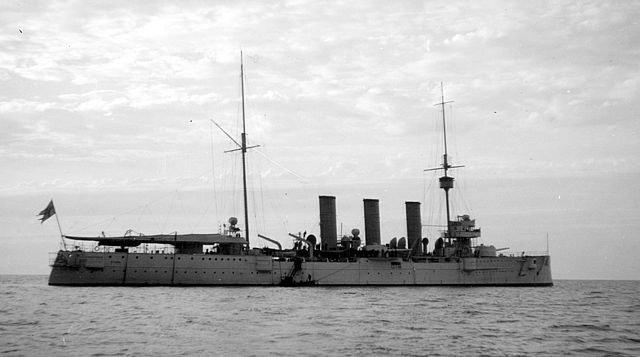
The smallest true armored cruiser in the world. This three-funnelled 5000 tons ship had an amidship waterline armored belt and her 6-in guns (152 mm) in twin turrets fore and aft on either beam. HSwMS Fylgia was laid by Bergsunds Mekaniska Verkstad in October 1902, launched on 20 December 1905 at Finnboda slip, Nacka to be commissioned on 21 June 1907. Upon her commissioning, she served actively but was used as a cadet training in the interwar and was comprehensively modernized prior to WW2.
As designed, Fylgia was armed with eight 152 mm/50cal. Bofors M/1903, fourteen 57 mm/48cal. QF M/1889 (10 in casemates), two 37 mm/39cal. cannons M/1898B and two 45 cm torpedo tubes M/1904 plus Mine rails installed for 100 mines.
During the first world war, in 1916, she received in addition two 57 mm/55cal. AA M/1889B while her mine rails were dismounted. Her wartime career was relatively uneventful. At the time of the outbreak of war, she was on her way to the Mediterranean, immediately canceled. She was used for neutrality patrols in home waters. She repeatedly repelled foreign warships entering Swedish waters.
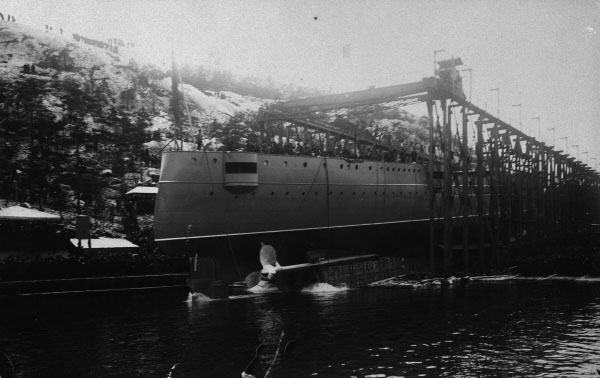
After the war, a new plan was developed for the coastal fleet and the new Swedish coastal Battleships would be protected by several layers of ships, about ten minutes this screen could be mobilized, including the Fylgia and Clas Fleming plus torpedo boats. On 12 December 1927 however, Fylgia collided with the Brazilian cargo ship SS Itapura at Salvador. The latter sank but her crew was rescued and the cruiser was sent to the drydock for repairs.
Soon after in 1930, she re-entered the drydock until 1940 for a complete modernization and rebuilding. Her 12 coal-fired Yarrow boilers were replaced with four oil-fueled Penhoët boilers. The three stacks were replaced by two. The main artillery has its range extended, a new fire control system installed.
Air defense now comprised four 57 mm M/89B-38B AA guns, two dual 40 mm m/36 guns with gyro-stabilized mounts, one dual 25 mm m/32, one 20 mm m/40 guns were also installed. The superstructures were also completely rebuilt. After this, she participated in WW2 to ensure neutrality, just as in WW1 and served well into the 1950s again as a cadet training ship, only decommissioned in 1953 and sold in 1957.
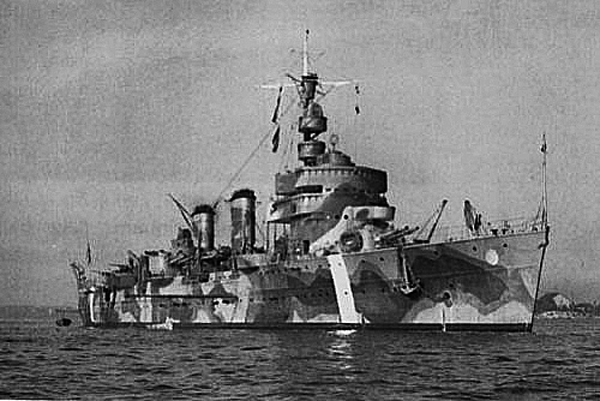
Fylgia as rebuilt in WW2, camouflaged and with white neutrality bands.
Fylgia 1914 |
|
| Dimensions | Length 115.10 x 14.78 x 6.30 m (383 ft 10 in x 48 ft 7 in x 20 ft 8 in) |
| Displacement | 4734 tonnes standard |
| Crew | 320 |
| Propulsion | 2 shafts, TE engines 12,000 ihp (8,900 kW) |
| Speed | 22 knots (41 km/h) |
| Range | 8,000 nmi (15,000 km) at 10 knots (19 km/h) |
| Armament | 8 x 6 in/50, 14 x 6-pdr, 2-in TTs |
| Armor (max) | KC and KNC, 4 in belt and 5in-2in turrets |
Minelayer Cruiser HSwMS Clas Fleming (1912)
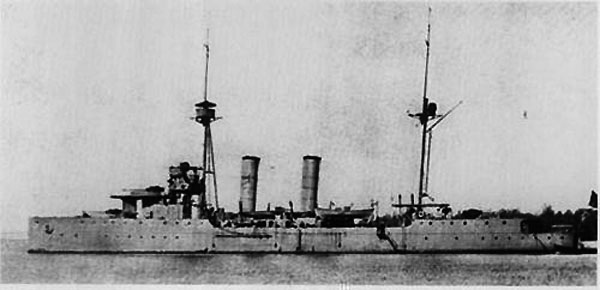
Clas Fleming in 1914
Compared to the previous Fylgia, the Clas Fleming (honoring one of the most revered Swedish Admiral of the XVIIth Century) was a minelayer cruiser, half the tonnage of the first. In fact she was so small even in 1910s standards that she barely belongs to the cruiser category, but German equivalents were quite small too. She was design for the task of carrying and laying mines quickly on sensible approaches to Swedish home waters and strategic points in 1908, approved and funded, then laid down at Bergsund Yard of Stockholm in 1911 and launched in December 1912.
She was eventually commissioned in 1914, the first Swedish Swedish warship to be fitted with Parsons steam turbines. She was originally armed with four 120 mm (4.7 in) guns in a superfiring arrangement, on the forward deck, forecastle (above the conning tower), poop deck and stern, which was lower. 190 naval mines could be carried on the main deck but the ship revealed herself to be very wet on rough seas (especially the lower stern).
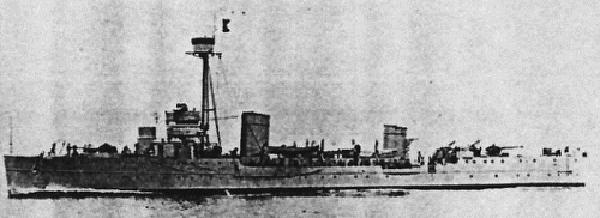
Clas Fleming in the interwar, after 1926 modifications
Therefore at the end of the Great war where she multiplied neutrality patrols and indeed laid minefields, she was rebuilt in 1918-19. Her poop deck was extended to the stern. However to avoid stability problems and excessive roll, the superfiring guns were moved to the sides, in sponsons amidships. In 1926 during a second refit, Clas Fleming received two additional 25 mm (0.98 in) Bofors AA guns. One was placed on top of the conning tower, two just behind the sides 120 mm guns.
The interwar was spent without notable incident, the ship being still used as a minelayer. However, by the early 1930s she started to show her age. In 1930, Götaverken built the first “warm air motor” tested on a tug. It was decided to adapt it for the Clas Fleming. It took five years to perform this. At last, in November 1939 the reconstruction was complete. She was extended with a 6 m (20 ft) section to accommodate the brand new four six-cylinder two-stroke diesel engines, the world’s first gas generators for turbines. Therefore only two boilers were kept, but modified to oil firing. As a consequence, she emerges with a very different silhouette in 1940: Three stubby funnels, a single short forward mast, a new firing director, and modified superstructures.
She spent the war in neutrality patrols, and after it, Clas Fleming was placed in reserve in Stockholm. She was eventually decommissioned on 1 January 1959, one of the longest-serving ship in the Western world.

Clas Fleming after reconstruction during WW2
Clas Fleming 1914 |
|
| Dimensions | Length 80.2 m (263 x 34 x 14 ft) |
| Displacement | 1,550 long tons (1,575 t) |
| Crew | 161 |
| Propulsion | 2 shafts Parsons Turbines, 8 Yarrow boilers 65,000 ihp (4,850 kW) |
| Speed | 20 knots (37 km/h) |
| Armament | 4 x 4.7 in (120 mm), 190 mines |
| Armor (max) | 16-25 mm belt, 75 mm CT |
Gunboats
Berserk/Hildur Class (1872)
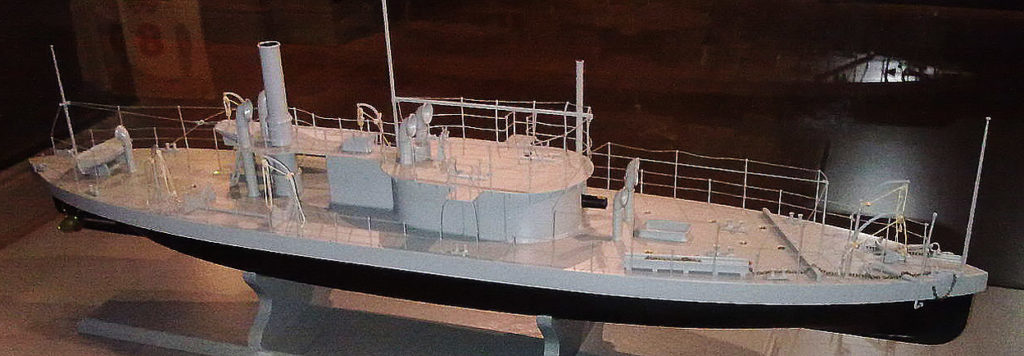
A 1/50 model of a Hildur-class ship.
Seven ships built at Nörkoping and Stockholm, launched 1872-75. They had been designed by a disciple of famous naval engineer John Eriscsson, called Lieutenant John Christian d’Ailly. Three were indeed conceived to be posted on border lake Mälaren and the Stockholm archipelago.
Technically they were monitor gunboats, with a shallow draft, 453 tons standard, measuring 39.7 x 8 x 2.59 m (130 ft x 26 ft x 8 feets 6 in). They were given a steam engine mated with two cylindrical boilers, connected to two propellers, rated for 133 to 155 ihp resulting i a top speed of 8 knots. They carried between 22 and 25 tons of coal. They were well armoured, with liminated armour plates, 3-1/2 in on the hull, 16-1/2 in down to 3 in on the turret. These ships were armed with a single 9.4 in gun/17 caliber (238 mm) in turret. These ships were agile, with two pairs of rudders and the bow and stern. Their crew was 48 officers and men.
These seven ships were still active in WW1, only two being reconstructed. Berserk and Ulf both had signal towers after refit in 1897-1898. They were all discarded in 1919 or 1922 (HSwMS Björn) but the last two. The class comprised the HSwMS Sölve (preserved at Gothenburg), HSwMS Folke, HSwMS Berserk, HSwMS Björn, HSwMS Ulf, HSwMS Gerda, HSwMS Hildur. Nowadays, HSwMS Sölve can be seen and visited at Gothenburg as a museum ship. She has long been used as a barge and was rendered to its original aspect.
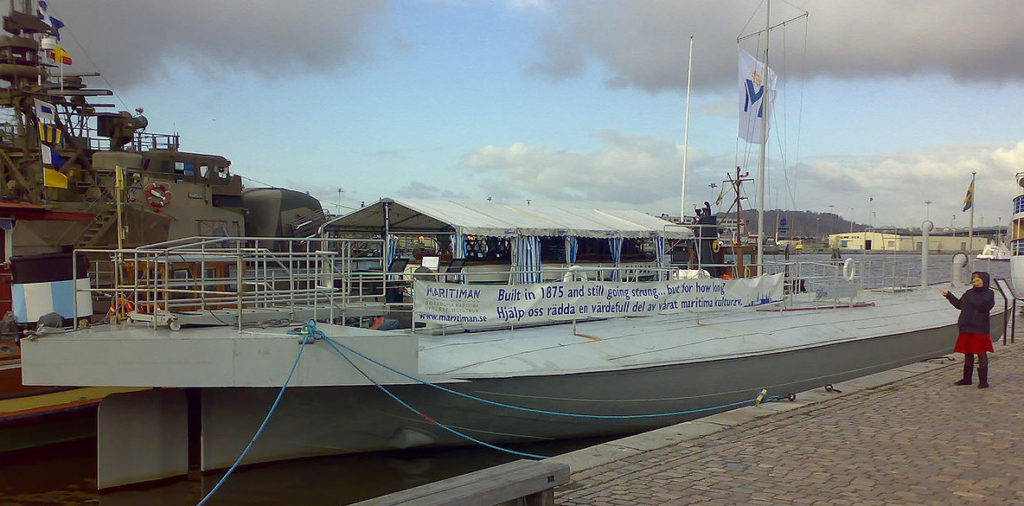
HSwMS Sölve preserved nowadays as a museum ship at Gothenburg. The design was from a disciple of John Ericsson, the inventor of the monitor.
Steam Corvettes (1865-85)
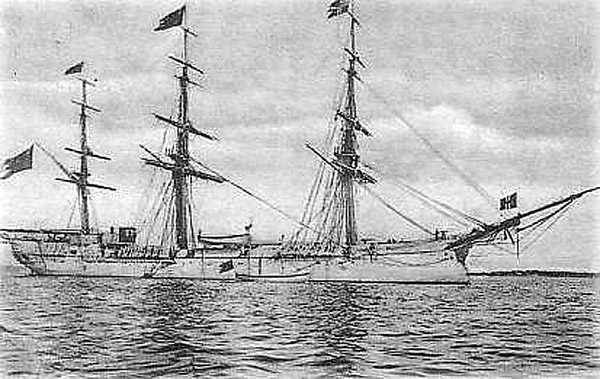
HMS Saga in 1900. In WWI, she was used as a training ship, alongside HMS Freja (1885).
In the 1860s, the Swedish Navy operated the sailing corvettes (latter class as gunboats) of the HSwMS Jarramas, Najaden, Carlskrona, Lagerbielke and Svalan. They were either converted to traditional cadet ships of resold, or discarded before WW1. However a serie of steam corvettes did served in WWI, from the 1870s. These were the HSwMS Freja, Gefle, Orädd, Balder, Saga, Thor and Valkyrian. The Vanadis was the only steam frigate (1862) in service but she was discarded long before WWI.
HMS Balder (1870) was a 1850 tons ship, 61.8 x 11.1 x 5.59m using a TE steam engine rated for 1850 ihp, enough for 12 knots. She also carried 270 tons of coal. She was armed with four 6.6 in breech loading gns and two 30 pdr.
We will focus here on the Saga and Freja which had a longer career as training ships. HMS Saga was 1590 tons in displacement, launched at Karskrona in 1878. Freja was the last one, built by Kockum and launched in 1885.
HMS Saga was built at the Karlskrona Yard, laid down on 7 August 1874, launched on 12 November 1877 and commissioned in 20 June 1878. She served until 25 June 1926. She displaced 1617 tons standard, measured 61 m (200.13 ft) by 10.2 m (33.46 ft) and 5.6 m (18.37 ft) and was capable of 11 knots (20.37 km/h) thanks to a TE steam engine and two cylindrical boilers. She normally carried a complement of 188 men to man the gun, the rigging and propulsion, plus cadets later. She was armed originally with a forward 167 mm gun, and six 122 mm guns. She was later rebuilt in 1888 to be specialized as a training ship with a foward 152 mm gun, eight 122 mm guns and a single 65 mm landing gun.
Örnen class Torpedo Gunboats (1898)
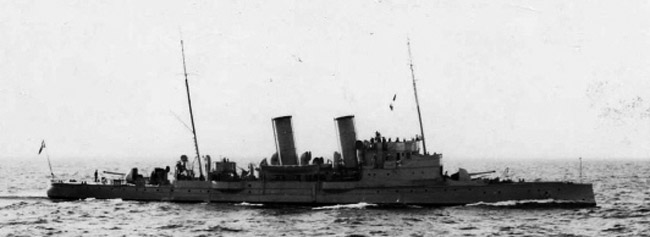
HSwMS Psilander
These five ships are sometimes classed as cruisers by some authors. But they were very small to reach that standard. The class comprised HSwMS Örnen (sunk as target 1950), Claes Horn (sold 1924), Jacob Bagge (sold 1949), Psilander (sunk as target 1939), and Claes Uggla (sunk 1917, she ran aground).
These ships were built at Lindholmen, Kockum, and Bergsund. They displaced 801 to 833 tons standard, were 67.72 by 8.20 by 3 m in size (220 x 26 x 10 feets). The last two were larger (Psilander and Clas Uggla), measuring 70.71 x 8.30 x 3 m (232 x 27 x 9 feets). They were propelled by a triple expansion steam engine lated to two cylindrical boilers rated for 4000 to 4500 hp, enough for 20 knots. They only carried 100 tons of coal. Crew was 99.
They were armed with two 120 mm (4.7 in) guns, four 57 mm (2.2 in) guns, and one 38 cm (15 in) torpedo tube, which was a bit short for ships denominated as “torpedo gunboats”.
200-tons second class gunboats
Blenda class (1874)
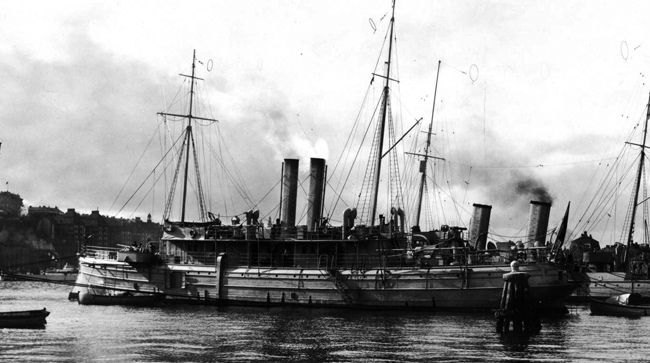
Two ships, Blenda and Disa built at Gothenburg (1874) and Karlskrona (1877) respectively. They displaced 427 tons, for 51 m, and their machinery was rated for 590 hp, which provided a top speed of 11.5 knots. She was armed with a single 10.8 in gun and one 4.7 in RML. Still active in WWI.
Urd class (1877)
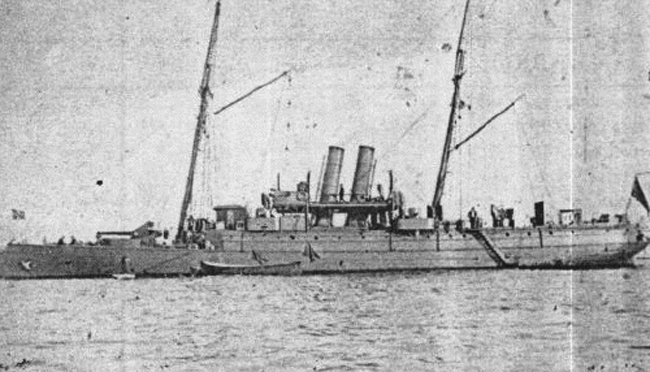
This class was comparable to the previous Blenda, displacing more at 527 tons for 52 m long, and armed the same. But they were faster at 13 knots, for 780 ihp. The class comprised the Urd (Malmö), Skagul, Skaggald, Rota (Stockholm), Skuld, Verdande (Karlskrona). In time, on both classes, the 4.7 in RML was replaced more modern 4.7 in/24 or 28 breech-loading gun. Prior to WWI also the 10.8 in gun was replaced by a 6in/26 or 32 caliber on Disa, Urd and Skagul, which were also fitted with a conning tower, protected by 1.7 to 2 in steel plating.
HMS Edda (1885)
Edda was a single ship built at Karlskrona, displacing 630 ihp , 56 m long (183 ft 9 in), powered by a TE engine rated for 960 ihp, giving a top speed of 13.6 knots. She was armed at the origin with a single 10.8 in/24, a 6-in/26 and two 1-1/2 pdr QF guns. But she was later refitted as a minelayer and only carried four 6-pdr guns.
Destroyers
Mode & Magne (1902)
Before the Swedes ordered any destroyer, they ordered two ships in UK, respectively HMS Mode (1902) to Yarrow and HMS Magne (1905) to Thornycroft, to decide was design was best. So the ships differred in many points. First, as they were both four-funelled, the Mode displaced 394 tons for 67 x 6.2 x 2.6m in size, and was powered by turbines rated for 5800 ihp, enough for 30 knots. Magne was shorter (65.7 m) but wider (6.30 m) and therefore displaced 423 tonnes. She needed more power (720 ihp) to reach the contracted 30 knots. Both carried about 80 tons of coal and the same contracted armament, six 6-pdr guns and two 18 in torpedo tubes in single tubes aft on the centerline. On trials Mode reached 32 knots (6800 ihp) by using apparently oil fuel sprays in combustion. On trials Magne made 7700 hp in forced heat, for 30.8 knots. Both ships participated in WWI, as part of patrol squadrons.
Wale (1905)
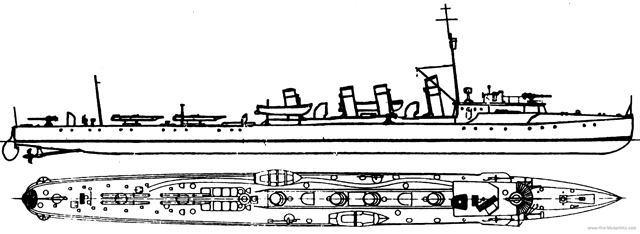
After having studied and tested both British design, the Swedish admiralty ordered a single pilot ship to Kockums yard at Malmö, inspired by HMS Magne. HMS Wale was launched 21.9.1907. She displaced 430 tons standard, 461 fully loaded. She was 66 m long by 6.3 m in width and 1.8 to 2.8 m in draught when fully loaded. She was propelled by two shaft VTE, fed by four Yarrow boilers. The group was rated for 7665 ihp, which procured a 30 knots contracted speed. Completed 14 april 1908, Wale was the first Swedish destroyer. On trials she achieved 8971 ihp, for 30.7 knots. She was armed with two 75 mm/53 model 05, four 57mm/55 model 89B and later from 1911, two 6.5 mm MG model 1910. Torpedo armament consisted in two 18 in (457 mm) torpedo tubes. During WWI the mounts were doubled, so four tubes total. Waled served until October 1940.
Ragnar class (1908)
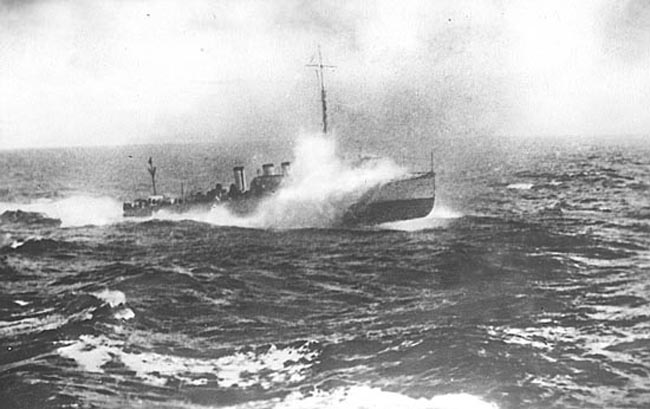
Three 430/460 ton ships modelled after the Wale, same size except the draught of 2.5-2.7 m. Powerpland was the same, but apparently registered less power, although top speed was unchanged. The class comprised Ragnar and Vidar, built at the same yard as Wale, and Sigurd, at Lindholmen (Göteborg). Armament was simplified and standardized as four 75 mm guns/50 model 1905, and two 18 in TTs, extended to twin mounts dueing the war. In 1940 all three ships were rearmed with brand new 75 mm guns, two 25 mm/64 guns AA Bofors and a twin 8mm MG mount. Names were chnged to pennant numbers 21, 22 and 23 and they served during WW2. HMS Vidar was only stricken in 1947 like the others but sunk as a target ship in august 1961. The other two were broken up in 1951.
Hugin class (1910)
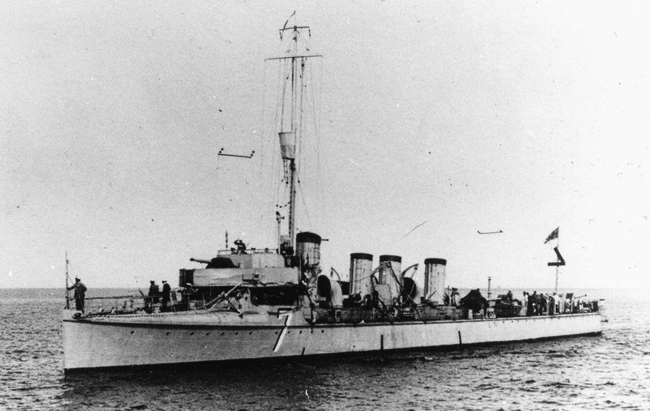
Slightly larger boats at 446 tons standard, these two boats were built at Götaverken (Hugin) and Kokcums (Munin). They were slightly larger at 66.10 m for 6.6 m in width (216 ft 10 in and 21 ft 4 in). Powerplant consisted this time in two German AEG-Curtis turbines, which produced a whooping 10,330 ihp, enough to reach 30 knots (33 on trials), while armament remains the same as above. Both ships served in both conflicts. In 1940 they became number 7 and 8. Both were rearmed also (as Ragnar class ?) but with mine rails adnd depht charges for ASW duties. They were also reboilered. Both ships were stricken in 1947.
Wrangel class (1917)
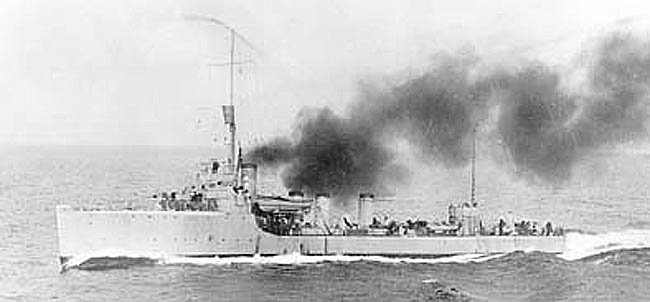
Wrangel and Wachtmaister were built at Lindholmen yard, completed in 1918. This was a wartime torpedo boat class, 415/498 tons in displacement for 72 m long and 6.9 m wide. They were propelled by two De Laval turbines coupled to four Yarrow boilers for a total of 13.000 hp and 34 knots top speed. These boilers were coal burning (105 tons) and converted to oil burning in 1927. They were armed with four 75 mm/53 model 1912 guns, two 6.5 mm MGs, and four TTs in one twin and two single tubes. They only saw the end of the conflict but participated in WW2, numbered 25 and 26, and rearmed in 1940 with new 75 mm guns, a single 25 mm AA gun, a twin 8-mm MG mount, while the two single TTs were removed. Two sister-ships named Ehresköld and Nordenskjöld were planned and later cancelled.
Torpedo Boats
First Class Swedish TBs (1884-1905)
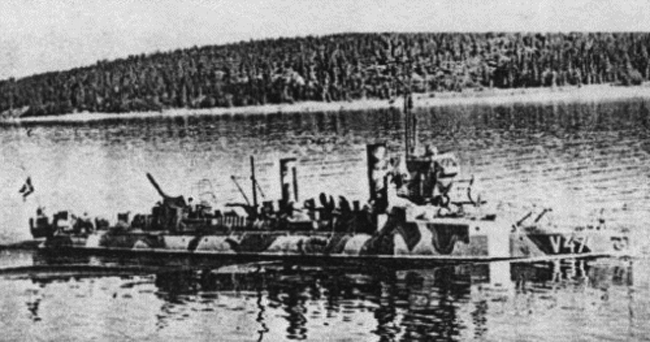
V47 Plejad class in WW2
This lot comprised disparate ships and a single cohertn class of 12 ships (Komet).
-N°1, and 2,3,4 were respectively from Thornycroft (pilot) and Bergsund, 1884 and 1887. These 66 ton ships, 34.8 m long, developed 620 ihp for 18.5 knots and were armed with a single MG and two bow 15-in TTs. This armament remained standard for all 1st class TBs until 1902 and the Komet that introduced two 1-pdr guns instead.
-Gondul class: Both TBs (Gondul, Guldur) were originated from Karlskrona yard in 1894. They were slightly larger at 38.6 m, developed 850 ihp for 19.5 knots and had two MGs instead of one.
-Komet class: 12 boats built at Schichau (pilot in 1896), Karskrona (Blixt, Meteor, Stjerna, orkan, Bris, Vind, Virgo, Mira 1898-1902), Bergsund (Sirius, Orion 1903), Lindholmen (Kapella 1904). They were slightly larger at 39 m, but with twice the power, 1050 to 1350 ihp which was enough for 22 to 24 knots. They also had a single bow TT and one trainable.
-Plejad: A single TB ordered from Normand in 1905. She was 38 m long, and her machinery was rated for 2000 ihp, resulting in a 26.2 knots top speed. Armament was the same as the Komet class, but with 18 in torpedo tubes.
All these ships were active during WWI in coastal harbor defence.
Second Class Swedish TBs (1882-1903)
These were thirteen small torpedo boats, numbered. Displacement ranged from 38 tons (Stockholm) to 43-45 tons (Thornycroft/Stockholm series), 55-57 tons for the rest. The serie started with N°61 and reached 85. They had been originally named but were affected numbers afterwards. The original N°1-7 were even more ancient spar-torpedo vessel, no longer acrive in WWI. These second class TBs were pure coastal crafts intended for defence harbour, ranging in size from 28 m to 32.4 m (N°83-85). Power ranged from 350 ihp to 700 ihp resulting in top speed between 16 and 20.8 knots. Armament comprised a single MG and a 1-pdr gun for the last series, one 14 in TT for the pilot, or two for the following, 15 in for the mid-series on the bow, and trainable.
Submersibles
Sweden was one of the first Scandinavian nations to have submarines in service when the first world war broke out. In total five were operational when the war broke out, thirteen more built during or after the war. Therefore Sweden built its own expertise in an autonomous way, which is recoignised today.
Hajen (1904)
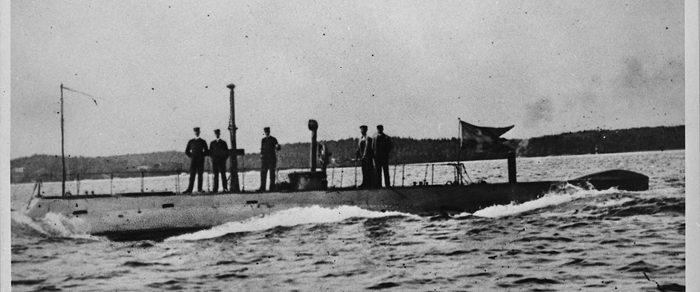
The first Swedish submarine was also buoilt locally, at Stockholm NyD. To gather informations, engineer Carl Richson was sent to the USA in 1900 to learn about submarine construction. In 1902 the parliament voted and authorized the building of a submarine which went on in total secrecy at a close and well guarded part of the yard, called “galley yard”. As built, launched on 20.7.1904 Hajen displaced about 107 to 127 tons standard and while diving. This was a small boat, 21.6m long and 3.6m wide, armed with a single 457 mm bow tube and three torpedoes in reserve.
But as for propulsion she used an unconventional Avance parrafin oil motor, and a Luth & Rosen electric unit which procured a top speed of 9.5/7 knots or 200/70 hp. However only 2.2 tons of parrafin oil could be carried, reducing the range. This solution proved so troublesome that it was replaced during the war in 1916 by a 4-cyl. diesel of 135 hp. Hajen was considered second class and ended in 1922 as a museum boat.
Hvalen (1909)

For this nexr test class, Sweden started to look at other countries, and retained the Italian double-hull design. Instead of acquiring a licence, an order was passed to Fiat-San Giorgio Yard at La Spezia. She was very much modelled after the Foca. In addtion she made headlines when the crew, arrived in italy, decided to make an unassisted cruise up to Sweden. Hvalen was 186/230 tons, 42.5 m long (for 4.3m wide), had a single shaft, three FIAT petrol motors (750 hp total) coupled to a 150 hp electric unit. Top speed was 14.8 knots in surface to 6 knots after diving. Armament comprised two 457 mm tubes in the bow, with one torpedo each in reserve. Hvalen was stricken in 1919 and sunk as target.
Undervattensbaten class (1909)
Small coastal submersibles numbered 2, 3 and 4 and built at Mokala, Verkstad. They were an improved version of the Hajen, designed for the archipelago.
They displaced 138/230 tons, 26.8 x 3.6 x 3 m in size, propelled by a single shaft 420 bhp Polar 6-cyl. diesel and a 200 hp Luth & Rosen electric unit for to top speed of 8.8 knots surfaced an d 6 after diving. Armament was a single bow 457 mm tube. They were stricken in 1929-1930.
Svärdfisken class (1914)
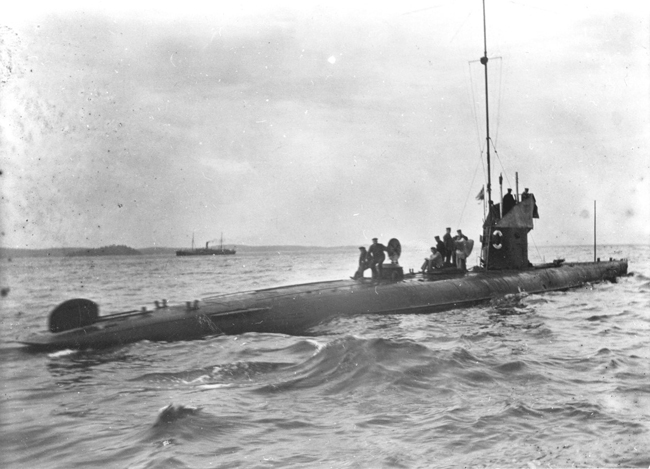
Ordered before the war, but launched in August and October 1914 respectively, HMS Svärdfisken and Tumlaren were built at Kockums Mekaniska Verkstad (Malmö). The Yard indeed purchased the licence of the Laurenti-Fiat design and provided an improved version of the Hvalen. The Yard subsequently became Sweden’s great specialist of the matter uuntil today. These were 252/370 ton boats, 45.1-45.5 x 4.2 x 3 m in size, propelled by two shafts mated to two 500 hp Hesselman diesels 6 cyl. and two 150 Luth & Rosen electric unit, for a top speed of 14.2 knots in surface, 8.5 when diving. They were armed by two 457 mm (18 in) torpedo tubes and one 37 mm gun which was later replaced by a 57 mm. Both were stricken in 1936.
Delfinen (1914)
A single submarine built at Bergsund yard, single-hulled, development from earlier 2nd class submarines, which had a reserve of buoyancy of 36t only but underwater performances were good as her hull lines were well refined. Her tonnage was 270/370 tons, size 42.5 x 4.3 x 3m, propelled by two 500 hp diesels Hesselman and two 150 hp electric motors. top speed was about 13.6 knots/9.4 in. Complement was 21. She was apparently armed the same way as the Svardfisken.
Laxen/Aborren class (1914)
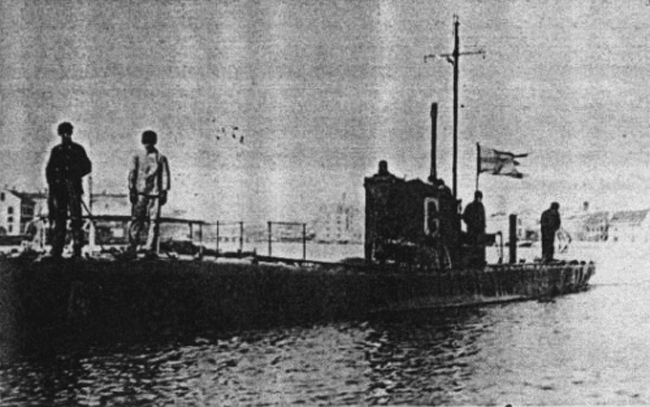
Four boats built in 1914, 1915 and 1916 at Karlskrona. Considered as second class submarines for the archipelago, the first being 140/170 tons and the second 174/310 tons, 26.8 or 31 m by 3.6m and 3.1 m in draught. Both were fitted with two shafts diesels 6-cyl and two electric motors, rated for 700/200 and 920/280 hp respectively, for a top speed of 8.8 to 9.5 knots in surface and 6.6 to 7.4 submerged. The Laxen and Gäddan had a single bow TT, 457 mm, while the Abborren and Braxen had two bow TTs and four torpedoes in reserve. They were striken in 1931 and 1937.
Hajen class (1917)
Three submarines built at Kockums, Malmö and base don a German design, Aktien-Gesselshaft Weser. The class comprised the Hajen, Sälen and Valrossen, launched in 1917 and 1918, completed too late to see the war. They served in the interwar and the first part of WW2 as they were stricken in 1943. These were 422/600 tons boats, 54 x 5.2 x 3.5 m in size, powered by two shafts and two 1000 hp 6 cyl. diesels, two 350 hp electric motors. Top speed, surfaced, was 15.5 knots and 9 knots submerged. They were armed with four bow TTs, 457 mm (18 in) and eight reserve torpedoes, plus a deck mounted 75 mm gun.
Bävern class (1921)
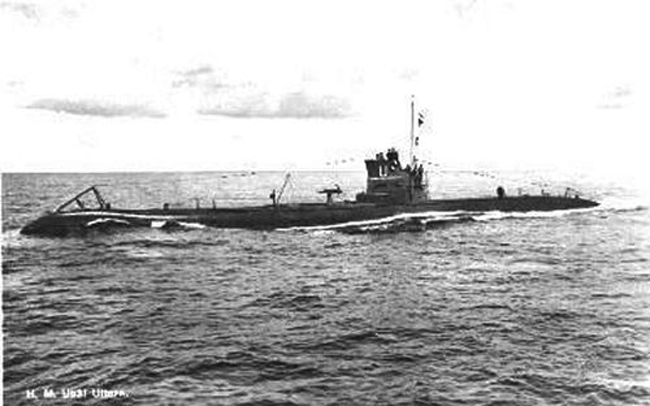
Derived from the first Hajen boats, aftert he war at Kockums and Karlskrona. The class comprised the Bävern, Illern and Uttern, launched in 1921. Specifications known shows they displaced 472/650 tons, were 57 m in lenght and 5.8 in width (187 x 19 ft), and had the same machinery, but more powerful, delivering 2100 hp and 520 hp respectively for a top speed of 15.2 on surface and 8.2 knots submerged. Armament was apparently the same as the Hajen. Crew was about 30. These three boats served in WW2, stricken in 1944 with the exception of HMS Illern which was rammed and sunk by mistake, later salvaged and towed to a broker.
Miscellaneous ships
Vedettbaten N:R 19 (1914)
A single ship built at Bergsund in 1914, for the archipelago defence. She also served as a searchlight vessel for night patrols. At that time she was unarmed and had only four searchlights. but in 1917 she was transferred to the Navy and received an armament of one 57 mm/55 Model 1898B gun, and a single Madsen MG. She displaced 58 tons, 67 deep loaded, for 22.8 m long and 4.9 wide. For propulsion she had a Bergsund crude oil motor allowing a top speed of 10 knots. In 1919 she was converted as a tender for the naval air wing, role she still had during WW2. She was stricken in 1947.
Sökaren class minesweepers (1917)
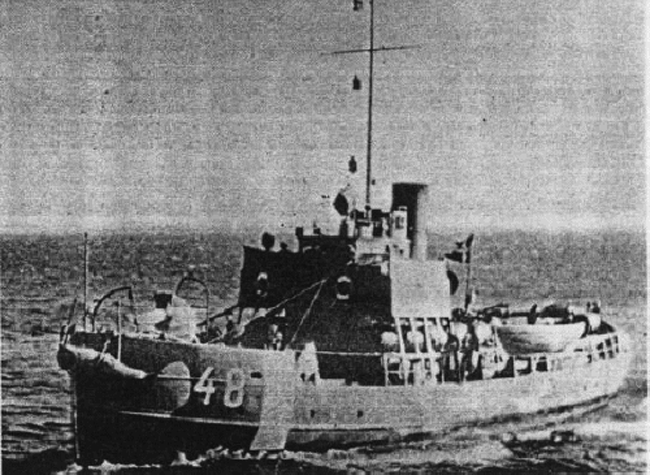
Three ships, Sökaren, Sveparen, and Sprängaren, built at Motala Verkstad in 1917-18. Construction was financed -interestingly enough – by what was left of the public funding for the battleship Sverige. They served as minesweepers, tendres and tugs during their long career since they served in WW2 and the early cold war, until 1961-64, while Sökaren was sunk in 1953, but later repaired and reused in ciilian service for many more years. These ships displaced 227 tons standard, up to 266 tons fully loaded, measured 27.8 m by 6.8 m and 3 m draught. They were propelled by a single shaft Motala VTE and one Howden boiler, rated for 465 hp. This made for a blasting speed of 10 knots. With a crew of 17 they were armed with a single 57mm/21 guns and three M16 75mm (3 in) Bofors AA guns.
Read More
wikipedia: List ships Swedish Navy
On fr.naval-encyclopedia.com
About the Hajen on marinmuseum.se
Sweden during WW1
Oscar II on navypedia.org
https://en.wikipedia.org/wiki/HSwMS_S%C3%B6lve

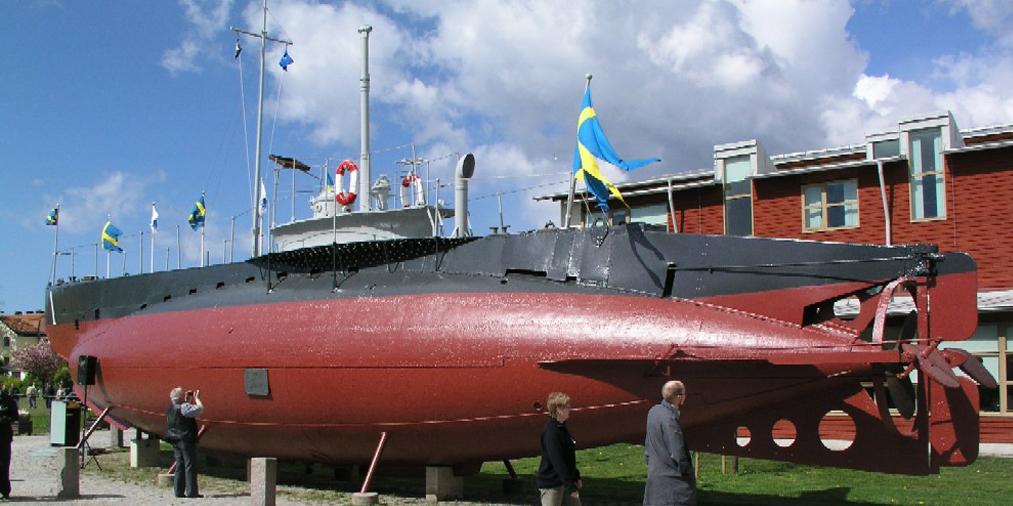
 Latest Facebook Entry -
Latest Facebook Entry -  X(Tweeter) Naval Encyclopedia's deck archive
X(Tweeter) Naval Encyclopedia's deck archive Instagram (@navalencyc)
Instagram (@navalencyc)





 French Navy
French Navy Royal Navy
Royal Navy Russian Navy
Russian Navy Armada Espanola
Armada Espanola Austrian Navy
Austrian Navy K.u.K. Kriegsmarine
K.u.K. Kriegsmarine Dansk Marine
Dansk Marine Nautiko Hellenon
Nautiko Hellenon Koninklije Marine 1870
Koninklije Marine 1870 Marinha do Brasil
Marinha do Brasil Osmanlı Donanması
Osmanlı Donanması Marina Do Peru
Marina Do Peru Marinha do Portugal
Marinha do Portugal Regia Marina 1870
Regia Marina 1870 Nihhon Kaigun 1870
Nihhon Kaigun 1870 Preußische Marine 1870
Preußische Marine 1870 Russkiy Flot 1870
Russkiy Flot 1870 Svenska marinen
Svenska marinen Søværnet
Søværnet Union Navy
Union Navy Confederate Navy
Confederate Navy Armada de Argentina
Armada de Argentina Imperial Chinese Navy
Imperial Chinese Navy Marinha do Portugal
Marinha do Portugal Mexico
Mexico Kaiserliche Marine
Kaiserliche Marine 1898 US Navy
1898 US Navy Sovietskiy Flot
Sovietskiy Flot Royal Canadian Navy
Royal Canadian Navy Royal Australian Navy
Royal Australian Navy RNZN Fleet
RNZN Fleet Chinese Navy 1937
Chinese Navy 1937 Kriegsmarine
Kriegsmarine Chilean Navy
Chilean Navy Danish Navy
Danish Navy Finnish Navy
Finnish Navy Hellenic Navy
Hellenic Navy Polish Navy
Polish Navy Romanian Navy
Romanian Navy Turkish Navy
Turkish Navy Royal Yugoslav Navy
Royal Yugoslav Navy Royal Thai Navy
Royal Thai Navy Minor Navies
Minor Navies Albania
Albania Austria
Austria Belgium
Belgium Columbia
Columbia Costa Rica
Costa Rica Cuba
Cuba Czechoslovakia
Czechoslovakia Dominican Republic
Dominican Republic Haiti
Haiti Hungary
Hungary Honduras
Honduras Estonia
Estonia Iceland
Iceland Eire
Eire Equador
Equador Iran
Iran Iraq
Iraq Latvia
Latvia Liberia
Liberia Lithuania
Lithuania Mandchukuo
Mandchukuo Morocco
Morocco Nicaragua
Nicaragua Persia
Persia San Salvador
San Salvador Sarawak
Sarawak Uruguay
Uruguay Venezuela
Venezuela Zanzibar
Zanzibar Warsaw Pact Navies
Warsaw Pact Navies Bulgaria
Bulgaria Hungary
Hungary

 Bundesmarine
Bundesmarine Dutch Navy
Dutch Navy Hellenic Navy
Hellenic Navy Marina Militare
Marina Militare Yugoslav Navy
Yugoslav Navy Chinese Navy
Chinese Navy Indian Navy
Indian Navy Indonesian Navy
Indonesian Navy JMSDF
JMSDF North Korean Navy
North Korean Navy Pakistani Navy
Pakistani Navy Philippines Navy
Philippines Navy ROKN
ROKN Rep. of Singapore Navy
Rep. of Singapore Navy Taiwanese Navy
Taiwanese Navy IDF Navy
IDF Navy Saudi Navy
Saudi Navy Royal New Zealand Navy
Royal New Zealand Navy Egyptian Navy
Egyptian Navy South African Navy
South African Navy






























 Ukrainian Navy
Ukrainian Navy dbodesign
dbodesign